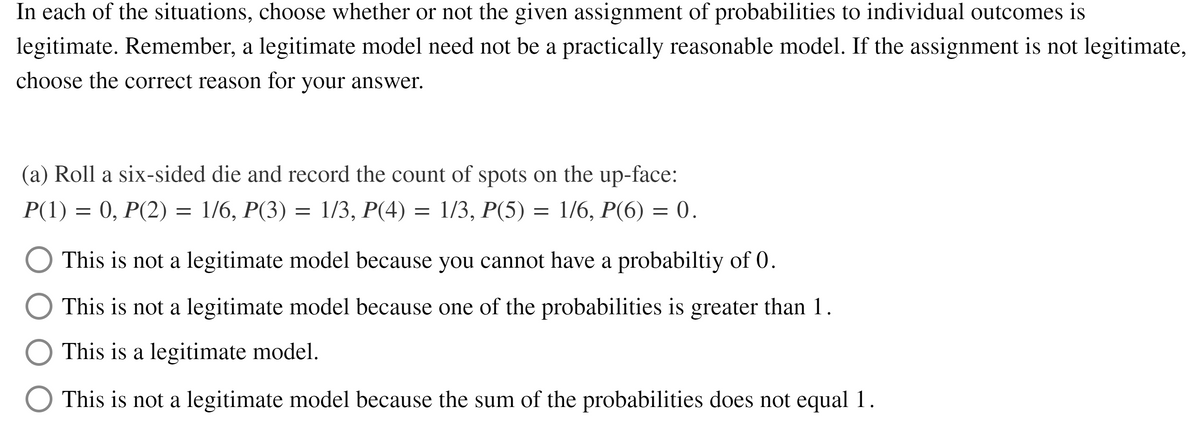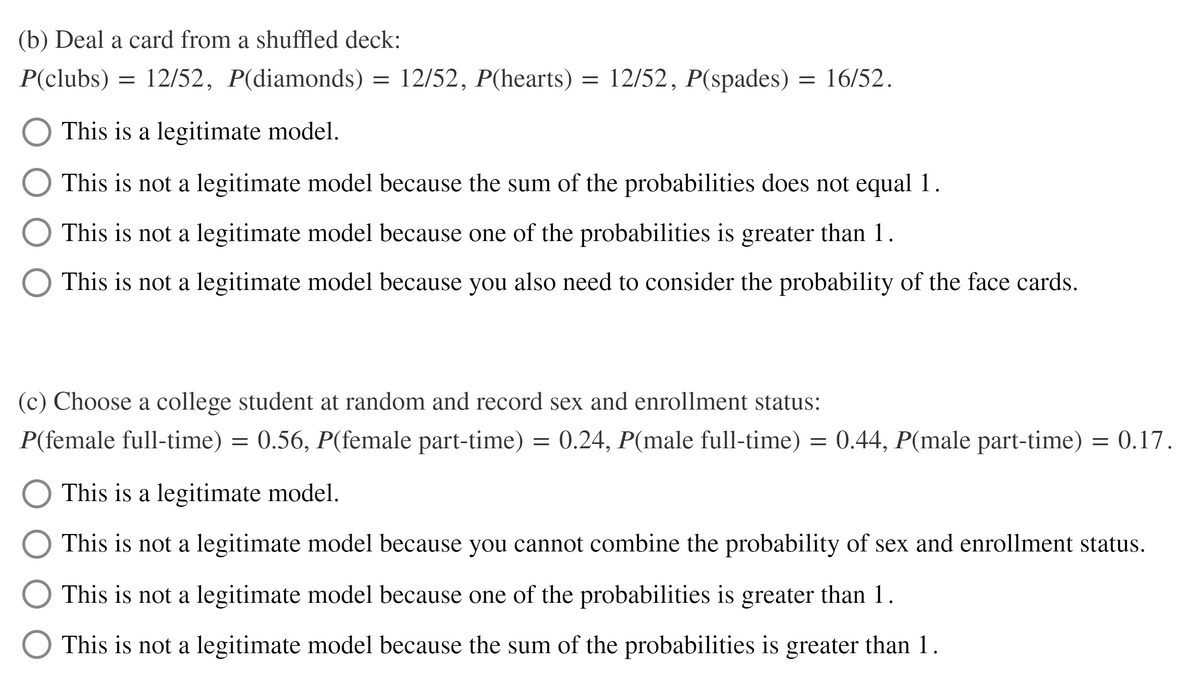In each of the situations, choose whether or not the given assignment of probabilities to individual outcomes is legitimate. Remember, a legitimate model need not be a practically reasonable model. If the assignment is not legitimate, choose the correct reason for your answer. (a) Roll a six-sided die and record the count of spots on the up-face: P(1) = 0, P(2) = 1/6, P(3) = 1/3, P(4) = 1/3, P(5) = 1/6, P(6) = 0. This is not a legitimate model because you cannot have a probabiltiy of 0. This is not a legitimate model because one of the probabilities is greater than 1. This is a legitimate model.
In each of the situations, choose whether or not the given assignment of probabilities to individual outcomes is legitimate. Remember, a legitimate model need not be a practically reasonable model. If the assignment is not legitimate, choose the correct reason for your answer. (a) Roll a six-sided die and record the count of spots on the up-face: P(1) = 0, P(2) = 1/6, P(3) = 1/3, P(4) = 1/3, P(5) = 1/6, P(6) = 0. This is not a legitimate model because you cannot have a probabiltiy of 0. This is not a legitimate model because one of the probabilities is greater than 1. This is a legitimate model.
College Algebra
7th Edition
ISBN:9781305115545
Author:James Stewart, Lothar Redlin, Saleem Watson
Publisher:James Stewart, Lothar Redlin, Saleem Watson
Chapter9: Counting And Probability
Section9.3: Binomial Probability
Problem 2E: If a binomial experiment has probability p success, then the probability of failure is...
Related questions
Topic Video
Question
Please Help!!

Transcribed Image Text:In each of the situations, choose whether or not the given assignment of probabilities to individual outcomes is
legitimate. Remember, a legitimate model need not be a practically reasonable model. If the assignment is not legitimate,
choose the correct reason for your answer.
(a) Roll a six-sided die and record the count of spots on the up-face:
P(1) = 0, P(2) = 1/6, P(3) = 1/3, P(4) = 1/3, P(5) = 1/6, P(6) = 0.
This is not a legitimate model because you cannot have a probabiltiy of 0.
This is not a legitimate model because one of the probabilities is greater than 1.
This is a legitimate model.
O This is not a legitimate model because the sum of the probabilities does not equal 1.

Transcribed Image Text:(b) Deal a card from a shuffled deck:
P(clubs) =
12/52, P(diamonds)
12/52, P(hearts) = 12/52, P(spades)
= 16/52.
This is a legitimate model.
This is not a legitimate model because the sum of the probabilities does not equal 1.
This is not a legitimate model because one of the probabilities is greater than 1.
This is not a legitimate model because you also need to consider the probability of the face cards.
(c) Choose a college student at random and record sex and enrollment status:
P(female full-time) = 0.56, P(female part-time) = 0.24, P(male full-time) = 0.44, P(male part-time) = 0.17.
This is a legitimate model.
This is not a legitimate model because you cannot combine the probability of sex and enrollment status.
This is not a legitimate model because one of the probabilities is greater than 1.
O This is not a legitimate model because the sum of the probabilities is greater than 1.
Expert Solution
This question has been solved!
Explore an expertly crafted, step-by-step solution for a thorough understanding of key concepts.
This is a popular solution!
Trending now
This is a popular solution!
Step by step
Solved in 2 steps with 2 images

Knowledge Booster
Learn more about
Need a deep-dive on the concept behind this application? Look no further. Learn more about this topic, statistics and related others by exploring similar questions and additional content below.Recommended textbooks for you

College Algebra
Algebra
ISBN:
9781305115545
Author:
James Stewart, Lothar Redlin, Saleem Watson
Publisher:
Cengage Learning


College Algebra
Algebra
ISBN:
9781305115545
Author:
James Stewart, Lothar Redlin, Saleem Watson
Publisher:
Cengage Learning
